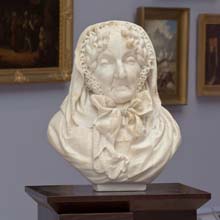
material: marble
dimensions: 48 × 44 × 35 cm
description: Walery Gadomski gained renown for the sculpture busts of his contemporary prominent personalities, e.g., Jan Matejko, Józef Szujski, as well as historical figures – Veit Stoss and Jan Długosz. Here he has portrayed a person who rendered no less great service to the communities of Krakow and Krzeszowice – Zofia Potocka. Zofia Potocka, née Branicka, (1790–1879) was the wife of Artur Potocki. She collected Italian paintings and was a member of the Archbrotherhood of Mercy and the Society of Charity. She founded a hospital and shelter for the poor in Krzeszowice and named it after her husband. Potocka provided patronage for the action of helping the injured in the January Uprising. Moreover, she was the initiator of the remodelling of St Leonard’s Crypt in the Wawel cathedral and the founder of the Rescue Office, which provided relief for fire victims. She also supported orphanages and old people’s homes and, last but not least, endowed scholarships for education in gymnasiums. The artist portrayed the aristocrat in a bust-length solid sculpture. The sitter is an elderly woman depicted en face. It is a realistic portrait: she has a wrinkled face, sunken cheeks, an aquiline nose and a bonnet with lace trim on her head, tied with a bow under her chin. The veristic portrait, capturing the likeness of a sitter without idealization, has been known since the time of ancient Rome and reserved for private use. It derived from the ancient tradition of taking death masks from the face of the deceased. Anna Budzałek
exposition: The Gallery of 19th Century Polish Art in Sukiennice,
The Cloth Hall, 1, Main Market Square
key: Realism, polish impressionism, beginnings of symbolism >>>
dimensions: 48 × 44 × 35 cm
description: Walery Gadomski gained renown for the sculpture busts of his contemporary prominent personalities, e.g., Jan Matejko, Józef Szujski, as well as historical figures – Veit Stoss and Jan Długosz. Here he has portrayed a person who rendered no less great service to the communities of Krakow and Krzeszowice – Zofia Potocka. Zofia Potocka, née Branicka, (1790–1879) was the wife of Artur Potocki. She collected Italian paintings and was a member of the Archbrotherhood of Mercy and the Society of Charity. She founded a hospital and shelter for the poor in Krzeszowice and named it after her husband. Potocka provided patronage for the action of helping the injured in the January Uprising. Moreover, she was the initiator of the remodelling of St Leonard’s Crypt in the Wawel cathedral and the founder of the Rescue Office, which provided relief for fire victims. She also supported orphanages and old people’s homes and, last but not least, endowed scholarships for education in gymnasiums. The artist portrayed the aristocrat in a bust-length solid sculpture. The sitter is an elderly woman depicted en face. It is a realistic portrait: she has a wrinkled face, sunken cheeks, an aquiline nose and a bonnet with lace trim on her head, tied with a bow under her chin. The veristic portrait, capturing the likeness of a sitter without idealization, has been known since the time of ancient Rome and reserved for private use. It derived from the ancient tradition of taking death masks from the face of the deceased. Anna Budzałek
exposition: The Gallery of 19th Century Polish Art in Sukiennice,
The Cloth Hall, 1, Main Market Square
key: Realism, polish impressionism, beginnings of symbolism >>>












